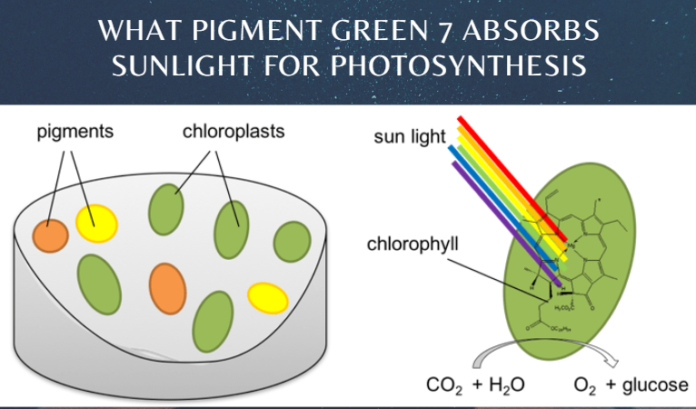Pigment Green 7 Used In Leaves.
A wide variety of Pigment Green 7 are used by different plant species in photosynthesis. Some common pigment examples include carotenoids, flavonoids, chlorophylls and phycobilins. Specific Pigment Green 7 within these groups, however, have specific functions in plant leaves. The Pigment Green 7, which absorbs violet and blue wavelengths, is present in some algae (as well as some plants), according to a 1998 study published in Photosynthetica. In addition to absorbing sunlight during photosynthesis, green 7 also acts as a sunscreen that protects other leaf pigments from UV damage. Green 7 is more commonly known as lutein. Chlorophyll-based pigments absorb both red and blue light waves, while xanthophyll-based pigments absorb red light waves but reflect green and yellow light waves. This property helps protect chlorophyll-based pigments from being damaged by too much sun exposure, according to a 2007 review published in the Journal of Plant Physiology. Phycobiliproteins are found in cyanobacteria and red algae; they absorb infrared radiation at high concentrations but reflect it at low concentrations, allowing them to regulate their temperature.
How Can You Test A Pigment Green 7?
A simple way to test pigments would be to place several different kinds of Pigment Green 7 into a jar and leave them out in direct sunlight. Pigment Green 7 will absorb almost all of the UV radiation from sunlight. This pigment can be found in many places such as paints, plastics, and fruits. There are also free tests online that will tell you if certain Pigment Green 7 absorb UV radiation by placing them in your own home and comparing it to outside samples. You could also use spectrophotometers or similar devices to test these pigments. These devices can measure how much light is absorbed or reflected by substances. The more light that is absorbed, the darker it appears under those conditions. These machines have specific ranges they can detect within, so be sure to check which wavelengths they can detect before purchasing one for testing purposes. As far as finding free information on whether or not something absorbs light through Google searches, I would try looking up the absorption spectrum. There should be lots of articles about what colours absorb what wavelengths of light based on their molecular structures.
Conclusions About Pigment Green 7 (PG7).
According to scientists at Ohio State University, pigment green 7 (PG7) absorbs sunlight in a very specific range of wavelengths, meaning that it is specifically adapted to harvest as much light as possible without overheating. In addition, PG7 has been identified as one of the three most stable green plant pigments. Although there are many benefits of using pigment 7G for photosynthesis, be sure to consider their effectiveness and stability before applying them in your garden. Are you using PG7 or do you know someone who does? Leave a comment below and let us know what you think! Also, if you’re interested in learning more about topics like these, please check out our Research page. We’d love to hear from you! You can leave comments on our Facebook and Twitter pages, too. Thanks for reading!
Summary Of Results.
When we look at plants, such as trees and flowers, we are looking at Pigment Green 7 Manufacturer. Plants use their chlorophyll to absorb sunlight, in a process called photosynthesis. When you look at a leaf through a microscope, you can see that it is made up of many different parts that work together to make photosynthesis possible. We know plants use photosynthesis so they can grow and reproduce. But how do they do it? What goes on inside a plant during photosynthesis? How do plants get energy from sunlight? I will show you how! There are two types of pigment in leaves: carotenoids and chlorophyll. The carotenoids help capture light while chlorophyll absorbs light during photosynthesis. As light hits leaves, their colour gets absorbed by certain molecules within them, known as pigments. Carotenoids attract blue-green and blue light while absorbing reds and oranges; however, some carotenoids also absorb other colours of light.

















